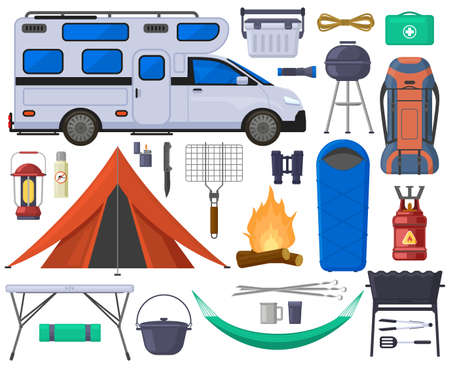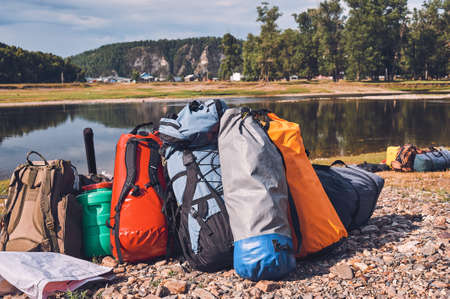Layer Up: The Importance of Proper Clothing
When it comes to winter camping in the U.S., your clothing choices can make or break your adventure. Layering is the secret sauce for staying warm, dry, and comfortable no matter where you pitch your tent—whether it’s the snowy Rockies, frosty Appalachians, or chilly Pacific Northwest. Start with a moisture-wicking base layer made from synthetic materials or merino wool to keep sweat off your skin. Next, add an insulating mid-layer such as a down or synthetic jacket to trap heat without weighing you down. Your outer shell should be waterproof and windproof to shield against unpredictable American weather conditions like sleet, snow, or biting winds. Don’t forget accessories: a warm beanie, thermal gloves, and thick wool socks are essentials. When picking gear, opt for materials that dry quickly and retain warmth even when wet—critical for those surprise snow flurries or rain showers common in many U.S. regions. Thoughtful layering not only protects you from the cold but also allows you to adjust easily as conditions change throughout your winter camping trip.
2. Shelter Solutions: Tents, Sleeping Bags, and Pads
When it comes to winter camping across the diverse climates of the United States, having the right shelter gear is absolutely crucial. Winter-ready tents, sleeping bags, and insulated pads are your first line of defense against snowstorms, biting winds, and subzero temperatures—whether you’re braving the Rockies or exploring the Adirondacks. Let’s break down what you need to stay safe, warm, and comfortable.
Winter-Ready Tents
Unlike their three-season counterparts, winter tents (often called four-season tents) are engineered to withstand heavy snow loads and fierce winds. Look for features like reinforced poles, steep-walled designs to shed snow, and minimal mesh panels for better heat retention. Vestibules are essential for storing boots and gear out of the weather.
| Tent Feature | Why It Matters in Winter |
|---|---|
| Double-wall construction | Reduces condensation and adds insulation |
| Steep-sided design | Prevents snow accumulation on roof |
| Extra guy-out points | Secures tent against high winds |
| Snow skirts/flaps | Keeps drifting snow outside your tent |
Sleeping Bag Ratings: Staying Toasty in the Cold
Your sleeping bag is your personal cocoon from the cold. For most U.S. winter camping conditions, choose a sleeping bag with a temperature rating at least 10°F lower than the expected nighttime low. Down bags offer unbeatable warmth-to-weight ratio but require careful handling if moisture is a concern; synthetic insulation performs better when wet.
| Sleeping Bag Type | Recommended Temp Rating (°F) | Best For |
|---|---|---|
| Down-filled mummy bag | -10 to 10°F | Crisp alpine nights and dry climates (Rockies, Sierras) |
| Synthetic mummy bag | -5 to 15°F | Damp environments or coastal winter trips (Pacific Northwest, Northeast) |
| Semi-rectangular bag with hood | 0 to 20°F | Milder southern states or car camping setups with extra blankets |
Pro Tip:
Add a sleeping bag liner for an extra 5–15°F of warmth and easier cleanup on longer trips.
Insulated Sleeping Pads: Your Barrier Against Frozen Ground
The ground can sap body heat faster than cold air alone. That’s why an insulated pad with a high R-value (thermal resistance) is non-negotiable in winter. Aim for an R-value of at least 4 for moderate cold; go above 6 for deep-winter expeditions or snow camping.
| Pad Type | Average R-Value Range | Main Benefit |
|---|---|---|
| Closed-cell foam pad + inflatable pad combo | 5–7+ | Layering maximizes insulation and comfort on snow or ice surfaces. |
| Self-inflating insulated pad | 4–6.5 | Packs small yet provides reliable warmth for most U.S. winter conditions. |
The Bottom Line:
A solid shelter system—winter tent, properly rated sleeping bag, and high-R-value pad—forms the backbone of any essential winter camping checklist. Don’t cut corners here; these investments mean more restful nights and safer adventures wherever your snowy travels take you.

3. Meal Prep in the Cold: Cooking Gear Essentials
When temperatures dip below freezing, a warm meal is more than just comfort—it’s fuel for your body and morale. The right cooking gear is crucial for winter camping, where traditional setups may falter in harsh conditions. Start with a reliable camp stove designed for cold weather; liquid-fuel stoves like the MSR WhisperLite or remote canister models outperform standard propane options when the mercury plummets. Pair your stove with windproof screens to maintain efficiency, even when gusts threaten to blow out your flame.
Insulated mugs are a winter camper’s best friend, keeping coffee, tea, or soup hot long after you’ve poured it. Look for double-wall stainless steel designs with sturdy lids—they’re durable and help prevent accidental spills around camp. Don’t underestimate the importance of quality food storage tools: hard-sided containers keep perishables safe from critters and insulated food jars allow you to prep meals ahead of time, preserving warmth until you’re ready to eat. Pack utensils that won’t snap in the cold (think titanium or BPA-free plastic), and bring collapsible wash basins to make cleanup easy—even when water freezes on contact.
With dependable cooking gear on hand, you’ll be able to prepare nourishing meals that stave off chills and bring everyone together around the campfire—no matter how fierce the winter weather gets.
4. Safety First: Navigation and Emergency Tools
When venturing into the American backcountry during winter, prioritizing safety isn’t just smart—it’s essential. Winter landscapes are breathtaking but can quickly turn hazardous with shifting weather, limited daylight, and unpredictable terrain. Equipping yourself with the right navigation and emergency tools can make all the difference between an adventurous memory and a dangerous situation.
Key Safety Gear for Winter Camping
| Gear | Purpose | Why It Matters in Winter |
|---|---|---|
| Headlamp (with extra batteries) | Reliable light source | Winter nights are long; essential for navigating after dark or in whiteouts. |
| Topographic Maps & Compass/GPS | Navigation tools | Snow can cover trails and landmarks—dependable navigation prevents getting lost. |
| Portable Charger/Power Bank | Keeps electronics powered | Batteries drain faster in cold; critical for keeping phones and GPS working. |
| Avalanche Beacon (Transceiver) | Avalanche rescue aid | Indispensable in avalanche-prone regions of the Rockies, Sierra Nevada, or Cascades. |
| First Aid Kit (winter-specific) | Treat injuries and cold-related issues | Includes supplies for frostbite, hypothermia, and minor accidents common in icy conditions. |
Navigating the Unique Challenges of American Winters
The diversity of America’s winter backcountry—from Vermont’s snowy woods to Colorado’s high-altitude passes—means hazards can vary widely. Always check avalanche forecasts before setting out, and never underestimate how quickly conditions can change. Carrying your phone isn’t enough; signal may be nonexistent in remote areas, so analog tools like maps and compasses are must-haves.
Pro Tips for Staying Safe:
- Double up on lighting: Bring a backup headlamp or flashlight to avoid being stranded in the dark if one fails.
- Lithium batteries: These perform better than alkaline in cold temperatures—use them for all electronic devices.
- Avalanche education: If traveling through avalanche terrain, take a course to learn how to use your beacon properly.
- Personal locator beacon (PLB): For extra peace of mind, consider a PLB to send SOS signals even off-grid.
- Cushion your first aid kit: Add hand warmers, blister treatment, and extra bandages for winter-specific injuries.
Your Peace-of-Mind Pack List:
If you’re planning a winter camping trip anywhere from the snowy Appalachians to the Pacific Northwest’s wild forests, remember: preparation is empowerment. Equip yourself thoughtfully—these navigation and emergency tools are your lifeline when nature shows its wildest side.
5. Keeping Comfortable: Extras Worth Packing
When it comes to winter camping, comfort can often make or break your trip. While you may have already packed the essentials, there are a few extra items that are frequently overlooked but can truly elevate your cold-weather adventure. Here’s a quick guide to those small comforts that make a big difference.
Hand Warmers: Little Lifesavers
Don’t underestimate the power of hand warmers. Whether tucked into your gloves, boots, or pockets, these compact heat packs provide instant relief from biting cold. They’re lightweight, affordable, and easy to stash in your backpack—making them a must for frosty mornings or late-night stargazing sessions around camp.
Camp Chairs: Take a Seat in Style
Sitting on snow-covered logs or frozen ground isn’t exactly inviting after a long hike. A portable, collapsible camp chair keeps you dry and comfortable at meal times or while swapping stories by the fire. Look for models with insulated seats or even built-in cup holders for extra convenience.
Moisture-Proof Bags: Protect Your Essentials
Winter means wet—whether from snow, sleet, or condensation inside your tent. Moisture-proof bags help keep your electronics, clothing, and snacks dry and safe from unexpected drips or spills. Opt for durable zippered pouches or roll-top dry bags to organize and safeguard your gear throughout the trip.
Repair Kits: Be Ready for Anything
The cold can be tough on equipment—zippers freeze, tent poles snap, and sleeping pad valves leak. A basic repair kit with duct tape, extra cordage, sewing supplies, and multi-tool is invaluable when things don’t go as planned. It’s peace of mind in a pouch and could save the day when you least expect it.
Small Comforts, Big Impact
Packing these often-overlooked extras ensures that you stay warm, organized, and ready for anything Mother Nature throws your way. On your next winter camping trip, don’t just survive—thrive by adding these little luxuries to your essential gear checklist.
6. Footwear & Hand Protection: Choosing the Right Gear
When it comes to winter camping, your hands and feet are often the first to feel the cold—and once they’re uncomfortable, your entire adventure can take a turn for the worse. Investing in proper footwear and hand protection is essential for ensuring every step and every camp task stays warm, dry, and safe.
Insulated Boots: Your First Line of Defense
Look for waterproof, insulated boots specifically designed for winter use. Opt for models with thick soles and robust insulation—think Thinsulate or PrimaLoft—to keep your feet warm even in subzero temps. Rubber outsoles with deep treads will provide traction on icy trails, while a gusseted tongue keeps snow from sneaking inside. In the U.S., brands like Sorel, Columbia, and The North Face are popular among seasoned campers for their reliability and comfort.
Gaiters: Sealing Out Snow & Slush
Don’t underestimate the power of a good pair of gaiters. These wrap around your lower legs and cover the tops of your boots, providing an extra barrier against snow, slush, and debris. They’re especially handy if you’ll be hiking through deep powder or wet terrain—keeping socks dry and heat locked in where it matters most.
Gloves: Layer Up for Dexterity & Warmth
Your hands need both warmth and flexibility during winter camping. Start with a moisture-wicking liner glove for sweat control, then add an insulated outer glove or mitten. Mittens generally offer more warmth but less dexterity; consider bringing both so you can swap depending on your activity. Look for windproof, waterproof materials like Gore-Tex to ensure your gloves stand up to snowy conditions.
Socks: Moisture Management Matters
Avoid cotton socks—they trap moisture and chill quickly. Instead, go for merino wool or synthetic blends that wick sweat away from your skin while providing excellent insulation. Bring several pairs so you always have a dry set ready at camp or after long hikes. For added coziness, consider sock liners or heated socks if you tend to get cold easily.
Local Tips: Layering & Fit
Remember: always try on your boots with the socks you plan to wear to make sure there’s enough room without being too snug (tightness can reduce circulation). And in true American style, don’t be afraid to double up on gloves or throw in some hand and toe warmers—comfort is king when camping under frosty skies!
With these essentials packed, you’ll step confidently into winter’s embrace—ready for whatever Mother Nature throws your way.


